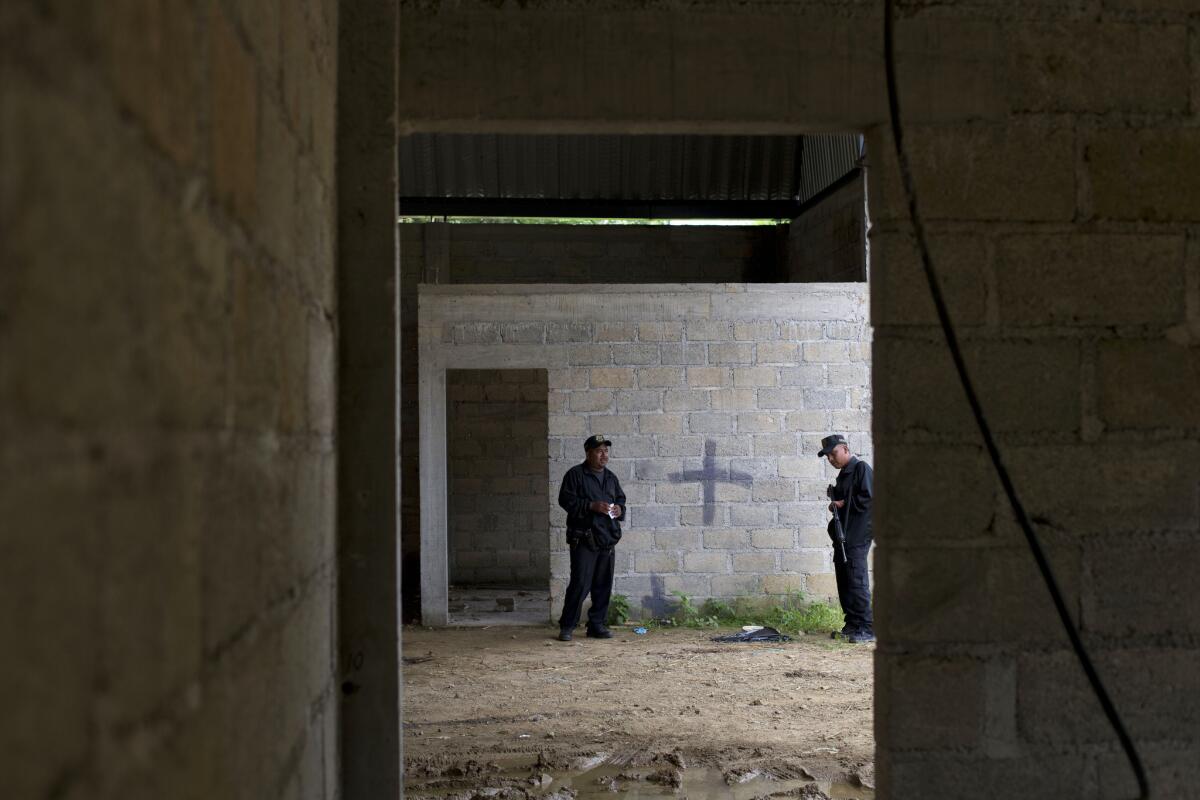Murder charges for Mexican soldiers raise more questions

- Share via
Reporting from Mexico City — The decision to charge three soldiers with murder in the June 30 killings of 22 suspected gang members was greeted with skepticism Wednesday by a public that has seen few human rights cases resolved.
The incident, in which only one soldier was wounded, was initially portrayed by the army as a fierce gun battle, an assertion backed up by government officials until mounting evidence from reporters painted a far different picture.
First the Associated Press and then other media suggested that many of the 22 may have been shot one by one, and they later quoted a purported witness who said the suspected gang members were wounded or surrendering when “executed” by the soldiers. The dead included the witness’ 15-year-old daughter, she said.
Forced to open an investigation, the federal attorney general’s office last week ordered the arrest of a lieutenant and seven soldiers, and on Tuesday said three of the soldiers would be brought up on homicide charges.
But Atty. Gen. Jesus Murillo Karam did not explain who was responsible for allegedly lying about the incident nor did he elaborate on what he acknowledged were “inconsistencies.” He said the investigation would continue.
“The story is full of holes,” said Sergio Aguayo, a political commentator and columnist for the Reforma newspaper. “Within the government, who knew what, and when?”
Aguayo compared the shootings in Tlatlaya to the 1968 massacre of students by the army in the Mexico City zone of Tlatelolco, a watershed moment in Mexican history. The killings 46 years ago this week were also covered up for some time by authorities.
“At the very least, there is one incontrovertible fact: The Defense Ministry and the state of Mexico [where Tlatlaya is located] lied to us,” columnist Katia D’Artigues wrote in Wednesday’s edition of El Universal newspaper.
Murillo Karam said the three accused soldiers entered a warehouse where the suspects had taken refuge and, though the shooting had stopped, opened fire “without any justification.” Twenty-one died; the 22nd person had been killed in the initial exchange of gunfire, he said.
But photographs obtained and released earlier by a local news agency appeared to show the dead men slumped against walls, guns propped next to them. Some had mud on their knees as if they had been kneeling.
Other unanswered questions include: How could three soldiers overpower 21 armed men, and would they really be acting on their own rather than following orders? Was the lieutenant in charge oblivious to what was happening?
This will be only the second time that soldiers are tried in a civilian court in a case involving alleged human rights abuse, despite a mounting number of reports claiming torture, murder and other violations by military personnel. Under pressure from international courts, the Mexican Supreme Court recently ruled that such cases must be transferred out of the military tribunal system to civilian venues.
The first case involved two indigenous women raped by soldiers in the early 2000s. Nearly a decade after the crime, two soldiers were arrested and tried.
Mario Patron, a lawyer and deputy director of the Centro Prodh human rights organization in Mexico City, said the Tlatlaya case was far from closed.
“The investigation must go much deeper … not only to determine whether more of the army personnel were involved in summary executions but also to have a better explanation of what actually happened,” Patron said in an interview.
“We cannot dodge the fact that eight were involved [in the direct shooting], but what about the control and supervision mechanisms, the chain of command? Was there any?” he added. “We cannot leave to one side the institutional responsibility.”
President Enrique Peña Nieto on Wednesday gave a ringing endorsement of the army’s behavior.
The army, he said, has promised to “take the necessary measures to clarify the facts,” he said in a speech on human rights.
“The Defense Ministry has lent its unrestricted cooperation so that the competent authorities can determine the judicial truth,” the president said. “I have confidence that the investigations will permit us to know the truth and reaffirm the Mexican state’s unflagging commitment to human rights.”
In another case of what authorities now acknowledge as the use of excessive force by security agents, nearly 40 university students remained missing Wednesday after police opened fire on groups of youths in Guerrero state, killing six.
Twenty-two municipal police from the city of Iguala have been arrested in the weekend shootings. Families of the missing Wednesday marched to government buildings in the Guerrero capital of Chilpancingo, demanding the return of their relatives.
A father, Mario Contreras, told reporters he saw his son being taken away in a police car, a claim echoed by several others. Contreras had a picture of the youth and what he said was the license number of the car.
Guerrero is one of Mexico’s most violent states, home to drug traffickers and other organized criminal gangs as well as rural self-defense militias, and with a history of insurgency.
Guerrero Gov. Angel Aguirre, who was subjected to an unusual reprimand from Peña Nieto to “assume responsibility” for the state’s deterioration, on Wednesday blamed the shootings on widespread infiltration of the Police Department by criminal gangs.
For more news out of Latin America, follow @TracyKWilkinson
More to Read
Sign up for Essential California
The most important California stories and recommendations in your inbox every morning.
You may occasionally receive promotional content from the Los Angeles Times.













